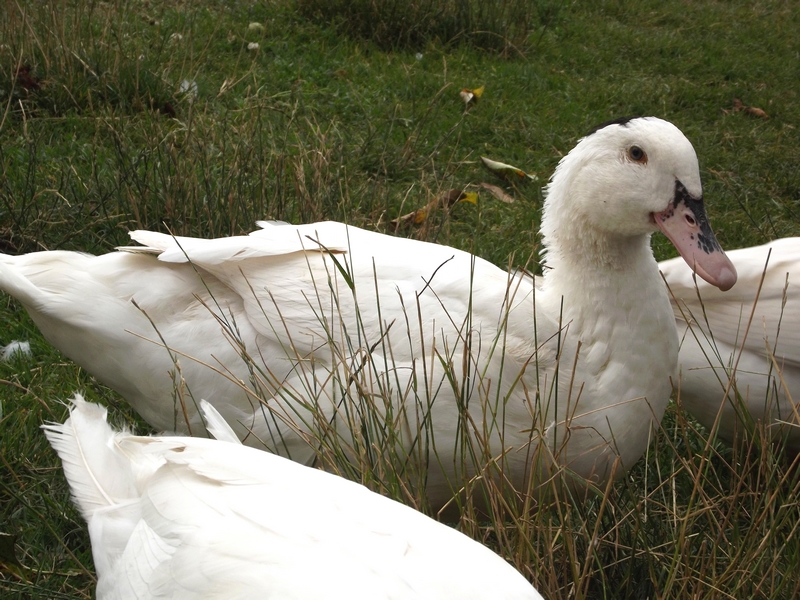Mulard ducks are a special kind of domestic duck. They come from breeding between the Muscovy and Pekin types. This created a new duck known as the Mulard. It has unique features like a crest on its head that catches the eye of duck lovers.
These ducks are not only beautiful but also big in size. Exploring Mulard ducks means looking at their looks, background, and what they need. Let’s learn more about Mulard ducks and why they are special.

Key Takeaways:
- Mulard ducks are a domestic type of duck resulting from crossbreeding between Muscovy and Pekin ducks.
- They are known for their unique physical features, including a crest on their head.
- Mulard ducks come in a variety of colors, such as white, black, and brown.
- Adult male Mulard ducks can weigh around 10-12 pounds and reach a height of up to 28 inches.
- These ducks have a lifespan of around 8-12 years.
Mulard Duck Behavior and Temperament
Mulard ducks are friendly and love to interact, which makes them great for people who want ducks to engage with. They get along with humans and other animals pretty easily. Being around them creates a calm and welcoming atmosphere.
They enjoy each other’s company and are happiest when with other Mulard ducks in a group. It’s suggested to keep at least three together. This ensures they’re socially satisfied and helps their general health.
Mulard ducks have a very even-tempered nature. They’re gentle and non-aggressive, resembling qualities anyone would want in their pets. Families and individuals looking for a gentle duck species often choose Mulards for their temper and friendliness.
“Mulard ducks are a delight to have around. They are curious, friendly, and always eager to socialize. Their calm and peaceful nature makes them a joy to be around.”
Group Quantity for Mulard Ducks
For Mulard ducks, it’s vital to have the right number of companions. At least three ducks are needed for a healthy social dynamic. This ensures they have friends to act normally and stay happy.
Choosing the correct number of ducks improves their mood and behavior. Since they love being social, it’s crucial for their wellness to have companions. This gives them a fulfilling life.
| Benefits of Keeping Mulard Ducks in a Group | Considerations for Group Quantity |
|---|---|
|
|
| Remember, the happier and more fulfilled your Mulard ducks are, the better their overall temperament and behavior. | |
Mulard Duck Uses in Meat and Egg Production
Mulard ducks are a top choice for meat. They are known for tasty, high-quality meat. These ducks grow quickly, reaching a good size for selling in just 12 to 16 weeks. With a lot of meat and little bone, they’re perfect for meat production. Each duck can yield 4-6 pounds of meat on average.
Mulard ducks are also great for eggs. They start laying at about 5-6 months old. The amount of light they get affects how many eggs they lay. With the right lighting, they can lay eggs all year round.
Mulard duck eggs are bigger than those from other ducks. Their eggs are prized for cooking because they’re so tasty and have lots of yolk. These large eggs are especially good for baking and cooking.
Mulard Duck Care and Husbandry
Keeping Mulard ducks requires you to meet a few important needs. You need to give them a right home, food, and clean water. Doing so will keep them healthy and happy.
Looking after their health is very important. This means they need regular check-ups and proper vaccinations. It helps keep them safe from diseases.
Eating the right food is also vital for Mulard ducks. They need a mix of commercial feed and added treats like veggies and insects. This ensures they get all the nutrition they need.
When it comes to feeding, offer them a mix of different foods. For example, give them commercial feed, but also some veggies and insect larvae. Make sure food is available for them throughout the day. This keeps them from getting too much or too little food, which can be harmful.
Taking care of Mulard ducks properly is key to having them as pets. It involves more than just a place to stay. Health checks, good food, and a steady feeding routine are all important for their well-being.
Mulard Duck Nutrition Guide
It’s very important to always give Mulard ducks clean water. This is for drinking and bathing. Also, keep to a regular schedule for feeding them.
By caring for them in this way, Mulard ducks can be great pets. They will add happiness to your home.
Mulard Duck Habitat and Conservation
Mulard ducks have specific housing needs. It’s vital to give them a warm, safe space. This should be big enough for them to freely move and behave as they naturally would. Such conditions boost their health both physically and mentally.
They also need a pond or water source. Ducks love water and use it for foraging and swimming. Make sure the water they access is clean and well-maintained. This helps keep them healthy and prevents illness.
Clean bedding is crucial for Mulard ducks. It stops the growth of harmful things like bacteria and parasites. By regularly changing the bedding, their living space stays comfortable and safe.
Raising Mulard ducks for food or as pets has its ups and downs. They’re prized for their meat and big eggs. But, caring for them needs plenty of time, care, and resources. Remember, meeting their needs is essential for their well-being.
The Mulard duck is not endangered, but their conservation is important. Through careful breeding and raising awareness, their population can stay healthy. This effort helps protect their unique mix of qualities.